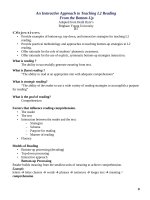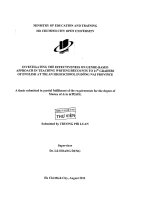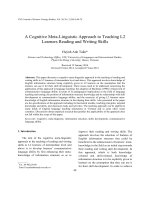skkn Genre-Based Approach to Teaching Writing
Bạn đang xem bản rút gọn của tài liệu. Xem và tải ngay bản đầy đủ của tài liệu tại đây (171.47 KB, 11 trang )
SƠ LƯỢC LÝ LỊCH KHOA HỌC
__________________________
I. THÔNG TIN CHUNG VỀ CÁ NHÂN
1.
2.
3.
4.
5.
6.
7.
8.
Họ và tên: Lương Thị Thu Hà
Ngày tháng năm sinh : 11/ 10/ 1975
Nam/Nữ:
Nữ
Địa chỉ: E 18 cư xá Tỉnh Ủy – Hà Huy Giáp- Quyết Thắng- Biên Hòa
Điện thoại:
Cơ quan: 0613829029
Nhà riêng: 0613829104
Fax:
E-mail:
Chức vụ: giảng dạy
Đơn vị công tác: Trường THPT Ngô Quyền
II. TRÌNH ĐỘ ĐÀO TẠO
-
Học vị (hoặc trình độ chuyên môn, nghiệp vụ) cao nhất: cử nhân đại học
Năm nhận bằng: 1998
Chuyên ngành đào tạo: Tiếng Anh
III. KINH NGHIỆM KHOA HỌC:
-
Lĩnh vực chuyên môn có kinh nghiệm: Tiếng Anh
Số năm có kinh nghiệm: 14 năm
Các sáng kiến kinh nghiệm đã có trong 5 năm gần đây: Tenses and aspects
1
SỞ GIÁO DỤC VÀ ĐÀO TẠO ĐỒNG NAI
Đơn vị : Trường THPT Ngô Quyền
___________________
Mã số: …………………..
SÁNG KIẾN KINH NGHIỆM
Người thực hiện:
Lĩnh vực nghiên cứu:
Có đính kèm:
Lương Thị Thu Hà
Phương pháp dạy học bộ môn
Phần mềm
Năm học: 2011- 2012
2
Genre-Based Approach to Teaching Writing
Abstract
This paper considers the application of genre-based approach to teaching of
writing in the English for Specific Purposes (ESP) context, especially for
learners aiming to use English in the professional setting. The genre-based
approach to language teaching attempts to teach learners the ‘moves’ of a
genre and to raise awareness of the linguistic features associated with the
moves as a way to overcome learners’ difficulties in writing appropriately
and effectively. This paper addresses the concern to help learners to make
their choices in deciding what kind of information should be put in their
writing to create meaningful and purposeful texts. A number of genre
analysis strategies are presented to demonstrate how learners can be taught
to modify and blend their choices of words according to the contexts in
which they write. 65 Business majors participated in this study. The control
group (N=30) were taught through the usual lecturing style while the
experimental group (N=35) were taught using the genre-based approach.
Following the multiple trait scoring of the learners’ texts, the texts were
analyzed for content, structure and language while the moves were analyzed
using the moves score. The results of the study indicate that learners do
write better when they are made aware of the rhetoric structure and
providing models seem to increase the salience of the communicative moves
considered by the learners for inclusion in their texts.
3
SangKienKinhNghiem.org
Tổng Hợp Hơn 1000 Sáng Kiến Kinh Nghiệm Chuẩn
Introduction
Writing is considered to be one of the most difficult skills learners are
expected to master. An ability to write appropriately and effectively is a task
that most ESL learners faced in spite of the years spent learning and
developing their writing skills. Writing is complex and multifaceted in
nature. Tribble (1996, p.57) posed a question pertaining to writing, “What
makes one piece of writing more acceptable than another?” Hopefully,
through the understanding of genre-based approach, taking the
communicative purpose as the key characteristic feature of a genre, this
question can be answered. This paper aims to investigate the effectiveness of
using a genre-based approach to teaching learners to use language
purposefully by using model text designed for specific professional context
which is referred to as modeling. It is a common technique used for teaching
genre where learners are presented with a model text that can be imitated
while they are writing their texts. There is no doubt that a model text varies
but basically, model text is seen as being exemplary of its kind written by
writer in specific situation that is subsequently reused to exemplify a genre.
Through modeling, learners duplicate the defining characteristic of its genre
but using a different content. The genre chosen for this study is an
adjustment letter.
Writing for technical or professional purposes presents many challenges to
learners as it involves many different areas of knowledge and skills. In most
cases, learners who have average proficiency of the English language still
perform poorly in their writing tasks, and most of them consistently exhibit
difficulties in expressing themselves in writing. In writing, it is essential that
learners do not just know how to write grammatically correct text but also
know how to apply their knowledge for particular purposes and contexts. A
focus on genres in writing instruction can provide the learners with a frame
that enables them to orient to and interpret particular communicative events.
A genre-based approach aims to make the learners more aware of the
concept of genre and the way it affects texts and increase their ability to
differentiate their language and text structure through the use of greater
linguistic choices.
Every discipline, profession and business has its own genres or conventional
forms of written communication. With its wide range of genres, it is quite
4
SangKienKinhNghiem.org
Tổng Hợp Hơn 1000 Sáng Kiến Kinh Nghiệm Chuẩn
difficult to teach or to predict the type of genres the learners need in their
future workplace. Moreover, there is not one model that can adequately fit
every situation. In short, the task of writing is obviously more challenging
for the novice writer who is not a native speaker. Therefore, learners must
know how to adapt certain constraints to fit the task at hand. Adopting a
genre approach relieves writers from having to create a new text or
communication for each situation. This is because genre arises from the
frequent recurrences of similar situations. Hence, learners can assimilate
what they have learned and put it into practice. In this aspect, modeling of
exemplary samples of prose can be introduced as a way to help learners to
achieve a better sense of purpose, form and direction in their writing.
Through modeling, they are made aware of the defining characteristics of a
text. With this awareness, they can then create a similar text using different
content to suit the task at hand.
The study
This study investigated the effectiveness of using genre-based approach to
teaching writing through the use of model texts. In particular the study
aimed to identify the moves of the adjustment letter, the allowable moves
order and the strategies used to realize the moves. From a language teaching
perspective, it is essential to view genre as consisting of a series of moves
(Swales, 1990). A move is considered as a part of a text which achieves a
particular purpose within a text. Apart from the analysis of moves, this study
also viewed the learners’ writing in terms of content, structure and language.
The following research hypotheses were addressed:
1. The participants will structure their writing through the moves
identified in the specified genre after genre-based instruction.
2. The participants will improve their ability to write better after genrebased instruction;
5
SangKienKinhNghiem.org
Tổng Hợp Hơn 1000 Sáng Kiến Kinh Nghiệm Chuẩn
Method
Participants
Sixty-five high school students - 11th graders enrolled in English for
Business Study II participated in this study. They were second year students.
All these students have passed their pre-requisite, English for Business
Study I before they could enroll in this English for Business Study II. On top
of this they were also asked to sit for an English Placement Test to ensure
that all of them have acquired a certain level of English proficiency in order
to participate in this study. The results obtained from the English Placement
Test indicated that there was no difference in their level of English
proficiency and the level of significance recorded was p= 0.837. In short, all
of them have the level of English proficiency needed for study.
Research Method
The Quasi-experimental study was used because under the present situation
the random selection and assignment were not possible. Therefore, sixty-five
students were designated to two classes. In other words, there were a mixedselection of students in a class comprising of the four main programmes,
namely Finance, Accounting, Business Administration and Marketing. The
general aim of the quasi-experiment was to examine the impact of a genrebased approach on the participants’ writing in Business context as in this
case, was on the adjustment letter. The writing task designed and
administered during this phase of the study aimed to measure the following
dependant variables: Context of Participants’ Text (CPT), and Written
Recall of Salient Points-The Moves (WRSP). In this research design, one
experimental and one control group were used in the study.
English 11- Unit 11: Sources of energy – Part D Writing
Describe the chart, using the information provided.
Genre: Description
6
SangKienKinhNghiem.org
Tổng Hợp Hơn 1000 Sáng Kiến Kinh Nghiệm Chuẩn
Length : 250 words
To understand a chart, it is important to firstly understand its topic.
The topic of a chart can generally be found by looking at its title. Pay
attention to the time reported in it as well. Is it the past, the present, or the
future?
Then, it is important to look for the general trend that the chart
describles. What patterns are shown? Is there an overall trend? How are the
different pieces of information related? Look for the exceptions to the
general trend, if there are any. Finally, look for the differences in detail.
T gets Students to work in pairs to study the 2000 charts on page 130
by asking questions like below and gives correction if necessary:
1. What is the topic of the chart? Does it describe the past, the present,
or the future?
2. What patterns are shown? How are the pieces of information
related?
a. Which made up the largest amount of consumption: petroleum,
coal, or nuclear and hydroelectricity?
b. Which consumption ranked the second?
c. Which made up the smallest amount of consumption?
Then teacher gets students to do Task 1
Teacher checks the answers with the class.
Then teacher gets students to read Task 1 again and review
the format/ organization of ideas in a graph/ chart/ table
description
After that, teacher helps students to review the language used
to describe tables/ charts/ graphs. E.g :
+ Verb tenses: When the chart shows the present situation, use the
present simple tense. When it shows the past events, use the past
simple tense. However, the simple present verb tense is often used in
the topic sentence. E.g:
The chart shows that …
The chart describes …
The chart presents …
+ Describing proportion: teacher might want to remind students of
expressions like:
Make up the largest/ smallest percentage/ proportion/ amount
contribute the largest/ smallest percentage/ proportion/ amount
This is followed by …
7
SangKienKinhNghiem.org
Tổng Hợp Hơn 1000 Sáng Kiến Kinh Nghiệm Chuẩn
This ranks first/ second …
Make up the largest/ smallest percentage/ proportion
Teacher gets students to study the 2005 charts in pairs.
T checks how students understand the data illustrated in the charts by asking
questions like below and gives correction if necessary.
- Teacher gets students to write the description of the charts. Students do the
task individually.
Describe the chart, using the information provided.
Procedure and Materials
Writing Topic: The learners’ task – to write an adjustment letter based on a
given scenario. Before the writing task was administered, the learners, both
the experimental and control groups undergone a series of workshops. For
the experimental group, their workshops were on genre-based approach
while the control group was taught based on the usual normal lecturing style.
Both the groups were given the same materials. Apart from the experimental
materials which were specifically highlighted to raise the learners’
awareness of the genre-based approach, most of the essential features of the
two studies remained identical.
Learners were given five exemplary model texts of an adjustment letter for
their modeling session. For the experimental group, the principle orientation
used for genre-based approach is based on the teaching learning cycle by
Martin, Christie and Rothery, 1987. The techniques used are ModelingNegotiation-Construction cycle. At the end of the eight weeks, learners were
asked to response to a claim letter.
Data Analysis
The participants’ writing task (the adjustment letter) was assessed in terms
of: Context of Participants’ Text (CPT) and Written Recall of Salient PointThe Moves (WRSP). The scoring procedure used for assessing the CPT was
based on the Multiple Trait Scoring by Hamp- Lyons (2003) and the
8
SangKienKinhNghiem.org
Tổng Hợp Hơn 1000 Sáng Kiến Kinh Nghiệm Chuẩn
instrument used for assessing the WRSP was based on the Moves Score by
Henry & Roseberry (1998). The results from the experimental and the
control groups were compared using the T-tests.
Results and Discussion
Both researchers Ellis (1990) and Schmidt (1990) through their empirical
studies, advocated that learners learn better through formal instruction as
they become more aware of the particular features of the target language and
form explicit representations of what they are taught. When learners go on to
notice the feature in the subsequent communicative input, acquisition of that
feature may occur.
This is very much reflected in what the learners wrote in their texts. The
results show that the writing task of both groups differed significantly at the
0.05 level, thus allowing the null hypothesis of no difference to be rejected.
As might be expected, the results from the three raters with regard to their
marking for the three criteria, content, structure and language, all show
(except from Rater 2 on language) that there are significance in the writing
between the control and experimental groups. Table 1.0 below shows the
mean rating and the level of significance obtained from the three raters of
the control and experimental groups in their writing task, an adjustment
letter. The mean results obtained seem to indicate that the experimental
group writes better in terms of the content, structure and language as they
are more aware of the linguistic features contained in this particular genre,
an adjustment letter. Through the modeling sessions, they are able to modify
and blend their choices of words according to the contexts in which they
write.
Table 1.0: Results showing the mean rating and the significance level
obtained from the three raters of the control and experimental groups in their
writing task, an adjustment letter.
9
SangKienKinhNghiem.org
Tổng Hợp Hơn 1000 Sáng Kiến Kinh Nghiệm Chuẩn
Criterion
Content
Structure
Language
Mean Rating
Group
Rater Rater Rater
1
2
3
Control group 2.35
2.23
2.39
(N=31)
Experimental 2.94
3.03
3.03
group (N=34)
Significance (p)
Rater Rater Rater
1
2
3
p=
p=
p=
0.019
0.003
0.017
Control group 2.00
(N=31)
Experimental 2.56
group (N=34)
2.42
1.71
p=
0.016
p=
0.016
p=
0.004
3.03
2.53
Control group 1.84
(N=31)
Experimental 2.42
group (N=34)
2.13
1.84
p=
0.028
p=
0.054
p=
0.009
2.65
2.62
According to Dudley-Evans (nd) genre analysis is particularly useful for
students with relatively little experience of writing. This seems to be the case
for the learners in this study as they only have two English courses in their
whole degree program. They found learning the genre-based approach to be
very useful as it has given them a sense of knowledge as what to write and
how to go about it. Hence, with an awareness of genre conventions, the
learners will have less difficulty in the ordering and reordering of the text.
10
SangKienKinhNghiem.org
Tổng Hợp Hơn 1000 Sáng Kiến Kinh Nghiệm Chuẩn
The data from the analysis of moves is ongoing but will be presented and
discussed in depth later.
Conclusion
The results of this study indicate that providing learners with explicit
knowledge of the genre of the adjustment letter can be beneficial to the
learners’ output in deciding what kind of information is appropriate and how
information can be organized.
In conclusion, I would like to view genre-based approach as an additional
approach to teaching learners to write better in a shorter period.
11









